Will it Fly? UVA Engineering Students Test Sabre 1 Rocket
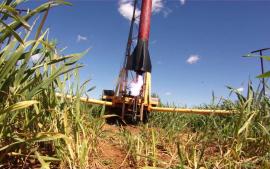
Sabre 1, an 11-foot-4, 60-pound rocket built by UVA Engineering students, is on its way. (Michael McPherson)
Wobbling slightly off the launch rail, the red rocket roared skyward, trailing flame, gas and smoke, climbing above 3,000 feet and reaching a speed of over 300 mph — almost half the speed of sound.
This wasn’t a Space-X launch. This was the liftoff of Sabre 1, the more than 11-foot-tall University of Virginia rocket. The location on this windy April morning was a farm field in Rapidan, Virginia, home of Tripoli Central Virginia’s Federal Aviation Administration-approved launch site.
But members of the UVA Rocketry club, a favorite extracurricular activity of students in the School of Engineering and Applied Science, knew much could go wrong during ascent, payload separation, parachute deployment and landing.
The stakes were high. The 60-pound rocket was the largest they’d ever flown, and the test was essential to know if they had a safe, fully functioning entry that could meet requirements for the Spaceport America Cup — the world’s largest intercollegiate rocketry competition, slated to take place June 17-22 in New Mexico.
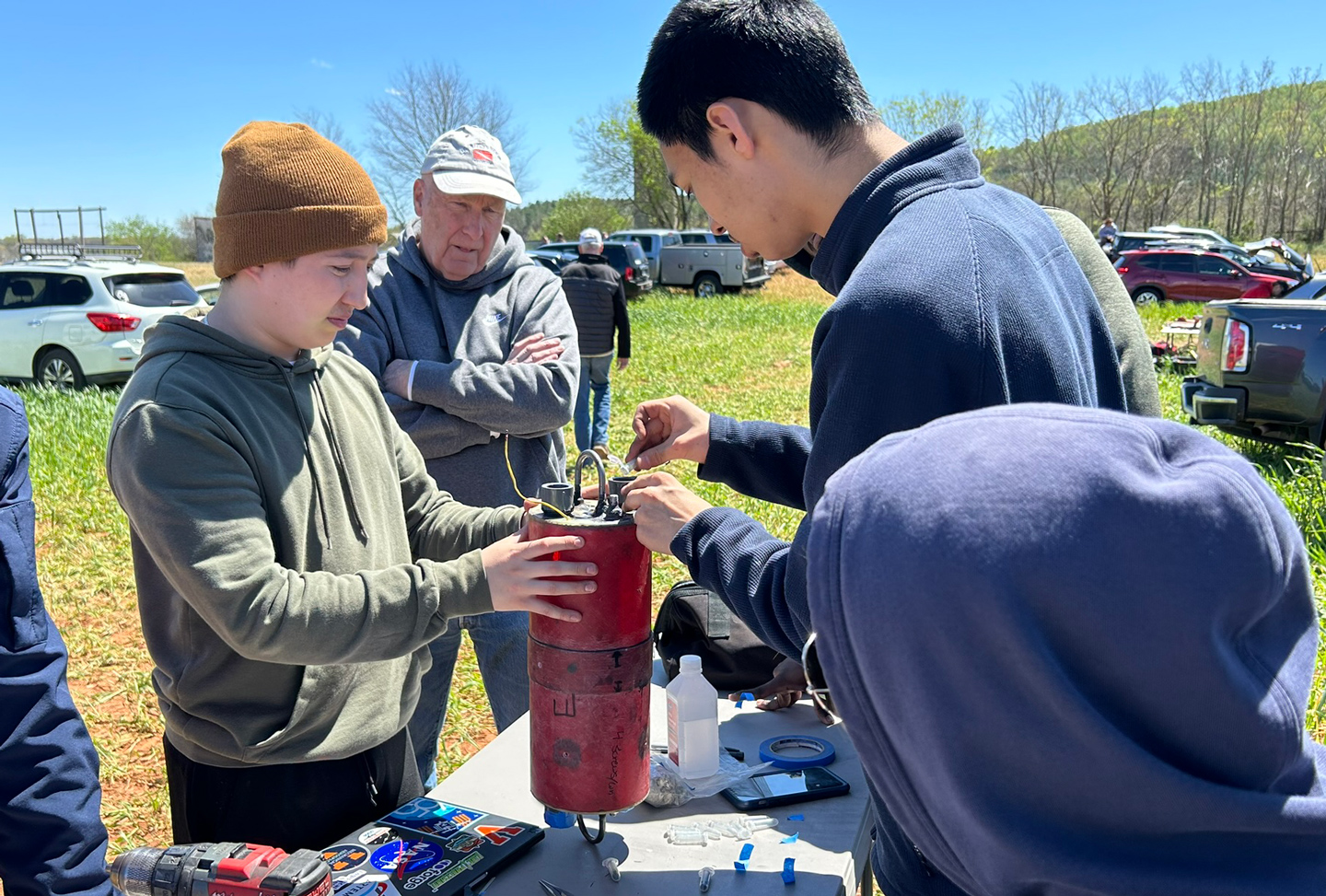
Preparing Sabre 1
Founded in 2016 with the New Mexico challenge in mind, UVA Rocketry waned during the COVID years. Current club president Daniel Tohti, a fourth-year aerospace engineering major and computer science minor, was determined to give it new life. The group had been important to him in choosing UVA.
Now it has about 40 members and supports activities ranging from research and development to helping students obtain high-powered rocket certifications through its affiliation with Tripoli, an organization that mentors collegiate rocketry groups.
“We have a diverse group of engineering majors. Some have previous experience, some don’t,” Tohti said. “The more people you have working on a project the better.”
You get to see engineering in action in ways that can’t be replicated in the classroom.
The preparations for Sabre 1 began in UVA’s Lacy Hall Student Experiential Learning Center. Over the past year, the students puzzled over simulations.
Why, for example, was the simulated launch speed too slow for the rocket they hoped to build?
They recalibrated. Ordered (and re-ordered) parts. Built the rocket, payload and electronics bay.
“You get to see engineering in action in ways that can’t be replicated in the classroom,” said flight performance lead Anne Marie Branch, a second-year aerospace engineering major.
“And the third- and fourth-years in the club have been incredible mentors and friends.”
A True ‘Field’ Test
Finally, they transported their rocket for field testing in Rapidan on April 13. The day started with tests on the ground of the two-parachute recovery system.
“If the rocket lands too hard, a fin could break off, which is fixable but would disqualify us if it happened on competition day,” Branch said.
“A lot of care goes into the decisions behind picking the size of the main parachute, which ultimately determines the impact velocity.”
With a burst of black powder smoke, the rocket popped in two, sending the smaller “drogue” — also known as a “drag” parachute because it slows rapidly moving objects — through grass and red-clay dust in the farm field.
“That was authoritative,” the range safety officer said. “I like a good strong charge.”
The drogue deploys first, keeping the vehicle from drifting too far, while the bigger main chute ensures a soft landing. Each ejects at pre-programmed altitudes.
Between the two is the electronics bay, housing altimeters to measure altitude (two for redundancy), along with GPS and other instruments. This “e-bay,” as the engineering students call it, also contains electronic switches that fire small black powder charges to separate the parachute chambers from the rest of the rocket. The sections are connected by shock cord so they don’t scatter.
“Some people use a CO2 canister for separation, but that gets more complex,” Tohti said. “Since this is our first time at the Cup, we went with simple designs for our systems.”
Where the drogue broke free with authority in its ground test, the main chute didn’t eject fully, prompting the team to increase the powder by a gram and retest with satisfactory results.
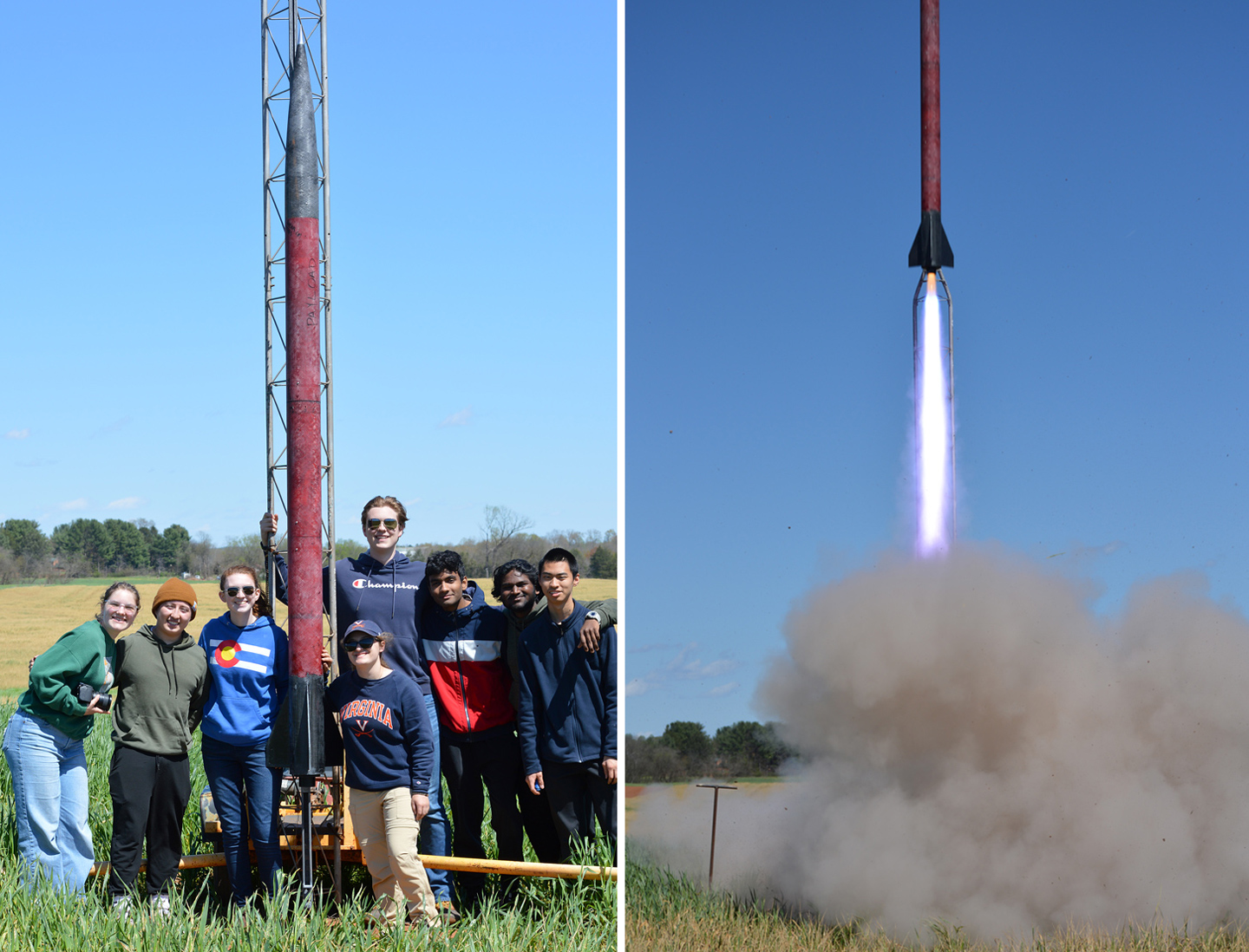
Countdown and Launch
You wouldn’t know it from the students’ pre-flight calm the next day, but the stakes were pretty high. This might be their only opportunity to test Sabre 1 and gather data before New Mexico.
Although Sabre 1’s target apogee — the rocketry term for the height they’re striving for — will be 10,000 feet in the Cup, one of the day’s challenges was keeping Sabre 1 under the FAA’s 4,000-foot limit for the Rapidan site.
For propulsion, they used a smaller version of the same commercial solid fuel motor they will use in New Mexico, which will fly twice as high and twice as fast.
The launch control officer counted down from five. The rocket ignited and Sabre 1 lifted off, spraying dust and debris from the launch stand.
That’s the moment that you kind of loosen up your shoulders, when you see the main parachute.
The students held their breath. They cheered only when the red and white parachute appeared — earlier than planned, but close enough to land the rocket safely a few thousand feet away.
“That’s the moment that you kind of loosen up your shoulders, when you see the main parachute,” Tohti said.
Branch described her relief and excitement. “I knew from the simulations that the descent velocities were good, but many factors during an actual launch can’t be modeled entirely,” she said. “Needless to say, we were very happy to find our rocket in perfect condition after impact.
“We finally have concrete proof that our recovery system works at sub-scale and will help us recover our rocket at the Cup.”
The Club’s Current Trajectory
While many of the UVA students are certified to fly Level 1 high-power rockets, no one, including club faculty advisor Michael McPherson, is certified for the motor they used in the test launch. At the Cup, Tripoli technical advisor Ben Russell will be the team’s Level 3-certified flyer of record.
To win their category, they’ll need to get as close to their target apogee as they can while carrying a payload of at least 8.8 pounds and recover the rocket.
“They have a real shot,” said a visibly proud McPherson, an adjunct professor of aerospace and mechanical engineering who also builds and flies rockets. He will be with the students at the competition.
For Tohti, an aspiring astronaut, Sabre 1’s inaugural flight was as important as a symbol of UVA Rocketry’s journey as it was a technical achievement.
The club’s come a long way in a short time. Last year, many of the same students were part of the team that took first place in the Deployable Payload Event at Tripoli Central Virginia’s Battle of the Rockets.
First Flight
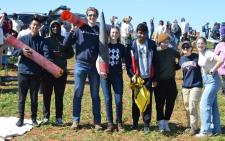
Edison Wong (from left), Abishekh Gurindapalli, Jack Spinnanger, Emma Lubeshkoff, Shean Rahman, Daniel Tohti, Anne Marie Branch and Jameson Phelps. (Michael McPherson)
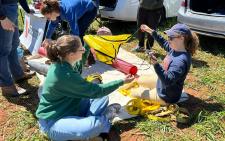
Jameson Phelps (left) and Anne Marie Branch pack Sabre 1’s drogue parachute.
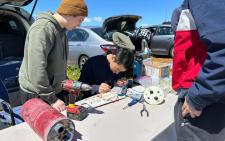
Edison Wong (right) works on the rocket’s electronics bay, which houses the altimeters, GPS and other telemetry.
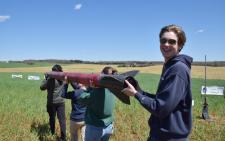
Off to work they go. Aerospace engineering third-year Jack Spinnanger, the team’s structures lead responsible for components such as the body and fins, is all smiles on the way to the pad. (Jameson Phelps)
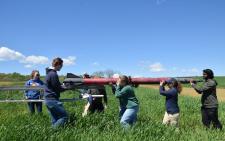
“Rail buttons” along the rocket body slide onto a track on the launch tower to keep it upright and stable during lift-off. (Michael McPherson)
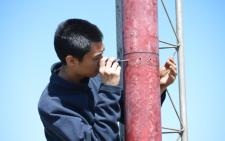
Edison Wong screws down electrical switches to activate the instruments. (Michael McPherson)

A separation test on the ground verifies the amount of black powder needed for the main parachute to deploy. The small blast creates enough pressure in the parachute chamber to shear it away from the nose cone. (Michael McPherson)

A view from below the rocket during ignition and lift-off. (Michael McPherson)
Learn More About UVA Rocketry
Dedicated to teaching and practicing basic rocketry principles through lectures, certifications and modeling so active members can design, build and fly rockets for scientific research and educational competition.